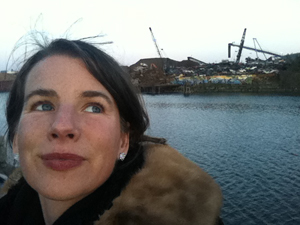Preservation and the Digital Artefact: Maleea Acker in Conversation
with Lisa Goddard

Local writer and nonfiction-board member Maleea Acker speaks with Lisa Goddard, Associate University Librarian for Digital Scholarship and Strategy at University of Victoria Libraries. The two discuss Goddard's role as panelist for Literary Afterlives: Exploring the Meaning and Values of Writers and Archives, one of three interactive panel discussions at this year's literary symposium, WordsThaw.
This panel will take place Saturday, March 19, 10:00 a.m. - 12:00 p.m. at the University of Victoria.
Collaboration between the humanities and other disciplines is increasing, and much of this work seems to be happening in the digital realm, with the advent of areas such as Geohumanities and Digital Humanities. What is the value of digitizing archival material in light of these collaborations?
One obvious benefit is vastly improved access. Many people around the world may be interested in a unique manuscript, journal, or illustration, but only a handful of those people will be willing or able to come to the University of Victoria to view the physical item. Digital surrogates can be easily discovered in web search engines like Google, and are immediately accessible online. This brings archival materials to a huge new audience of people who may never consider going to a physical archive. Digitization has additional advantages to scholars, as it permits a geographically distributed research team to work collaboratively on a collection of objects. Digital surrogates can be marked-up, rearranged, and mashed-up without harm.
What kinds of new scholarship is possible when working with digital archives?
When textual items are transcribed they can be manipulated in software tools that allow scholars to ask new questions about writing style, relationships between editions, or the evolution of an author's work over time. Text analysis tools are particularly useful in exploring large text stores. The Proceedings of the Old Bailey, for example, is a project that has digitized and transcribed the proceedings of 197,745 criminal trials held at London's central criminal court from 1674-1913. At a minimum this allows keyword searching of those materials, but sophisticated text analysis tools can also create maps and timelines, or perform statistical and linguistic analyses. High resolution images of artwork can be explored down to the tiniest brush stroke—a level of detail that wouldn't necessarily be apparent if working directly with the physical item. These digital tools complement traditional scholarly approaches, and allow researchers to explore source materials in ways that were previously impossible.
Many who remember the pre-digitalization library days of card catalogues, print newspapers and journals are suspicious of the era of digitalization, arguing (like Nicholson Baker) that libraries have a responsibility to preserve hard copy archives, especially in light of the limited life span of many digital formats. What are the unique challenges of managing digital archives? How is UVic addressing these issues? What would you like to see happen with UVic’s archives and will that include protection of both paper and digital collections?
In Archives and Special Collections the original physical object is of utmost importance. Digital surrogates have a variety of access benefits, but these never trump the importance of the original. Our digitization initiatives often result in more requests to view the original artefact. This may seem counterintuitive, but for many there is no substitute for the experience of holding a piece of history in your (gloved) hands; to touch and smell a manuscript that was rendered by the hand of someone who died more than a thousand years ago. It's thrilling to hold a physical object that has been carefully preserved and handed down through generations of other humans in order to survive to this moment. Digitization is a way of preserving a copy of an object against a worst case scenario like fire or flood, but these copies are never replacements for physical archival collections.
Libraries recognize the value of print monographs that, unlike eBooks, are enduring and immutable. We have thousands of years of experience preserving physical items, and less than ten years experience with digital preservation. Research libraries do their best to keep books on the shelf indefinitely, but published materials, those which are not rare or unique to our collection, don't receive the same level of stewardship as archival material. Space constraints and financial exigencies are constant pressures. Journals and periodicals are probably at greatest risk, as many of those titles are now produced and acquired only in electronic format. Most academic libraries rent access to electronic journals through annual subscriptions, and have little control over the long-term preservation of journal content. Long copyright terms and restrictive publisher contracts are eroding the role of libraries as long term stewards of the published record.
What is lost and what are the drawbacks of working with digital objects instead of the original materials? What is being done to mitigate these drawbacks?
Scholars often mourn the loss of physical browsing that can lead to serendipitous discoveries. Many archival researchers have come in looking for one thing, only to find something completely unexpected that changed the course of their entire careers. There are a number of formats that can't be easily viewed onscreen from large scale materials like maps and canvasses to 3D objects like clothing and sculpture. As technologies improve we can provide a more true-to-life experience of an object, we can add descriptive information to aid discovery, and we can add contextual information that helps to create narrative. No matter what we do to enhance our digital collections, though, we will never be able to match the full sensory experience of physical archival research. Keyword searching can't replicate the excitement of opening an archival box that hasn't been touched for years, to reverentially unpack and examine each object.
Where are libraries heading in the future? Do you see a time when paper copies of most materials will become a thing of the past? Will UVic follow the lead of many universities in the US, where transformation of shelf space into public collaboration space is taking place?
There is no question that an increasing proportion of our budget is spent on digital content, including journals, datasets, and streaming video, although libraries will continue to acquire print monographs for as long as they are produced and are in demand by our patrons. UVic Libraries are trying to find creative compromises like offsite storage, collaborations with other libraries, and compressed shelving that will allow us to create additional space for study and collaboration without sacrificing our physical collections. In our next major renovation we are planning to increase the space dedicated to Archives and Special Collections, and to add more climate-controlled storage for those materials.
Ultimately, though, archival collections reflect their historical contexts. We collect artefacts in their original media. As more authors compose on word processors and correspond via email, then author archives will inevitably become more electronic. Something is lost and something is gained in this transformation, but Archives will continue to collect, curate, and preserve cultural materials however they manifest.

Maleea Acker
* * * * * * * *









